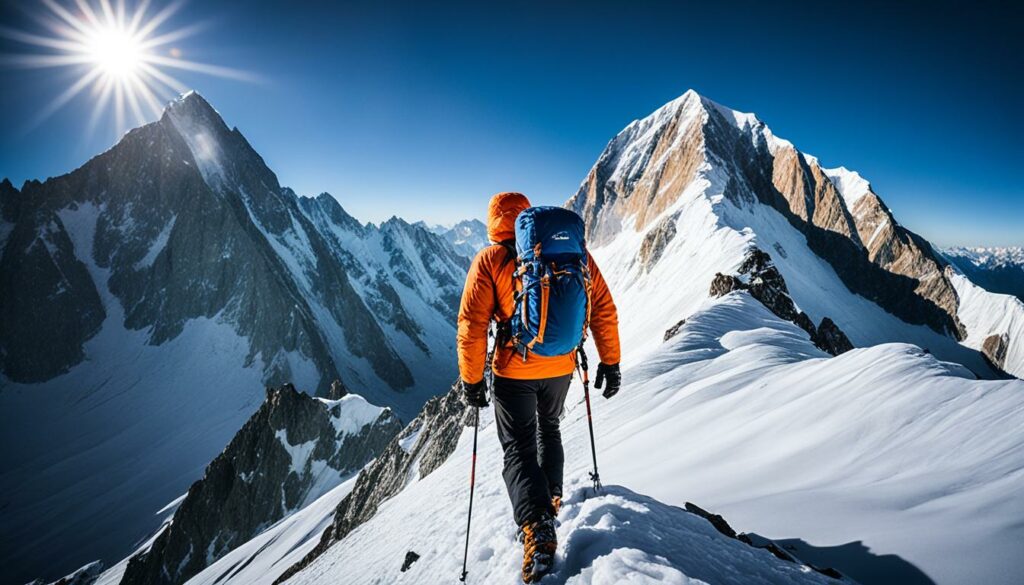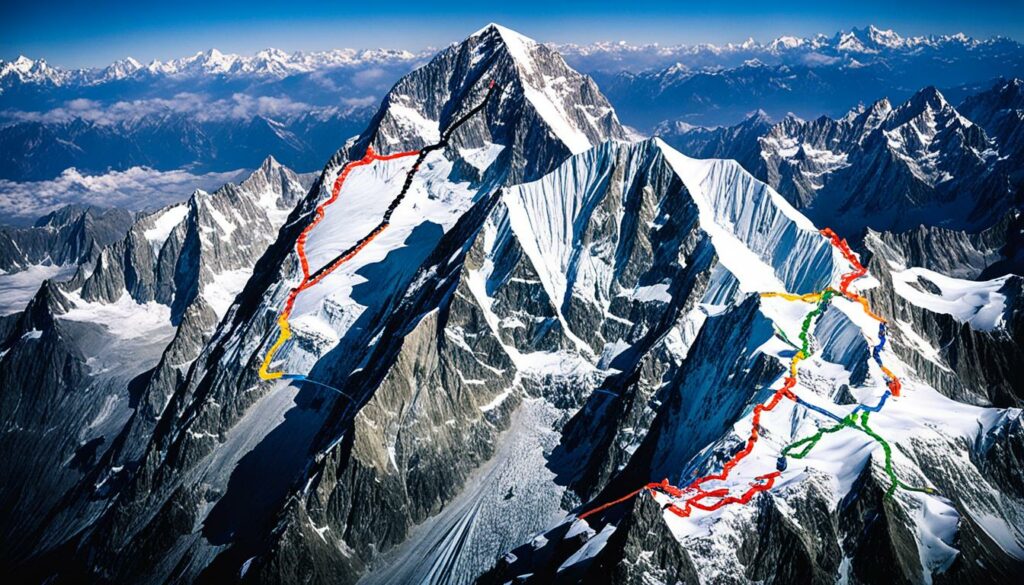“The summit is what drives us, but the climb itself should be our focus.” – Conrad Anker
Embarking on the journey to climb Broad Peak is a test of physical and mental strength. Tucked away in the Karakoram Range, Broad Peak offers adventure seekers an opportunity to conquer an 8,000-meter peak and experience the thrill of high-altitude mountaineering. But before setting foot on this majestic mountain, climbers must decide which route to take, each presenting its own set of challenges and rewards.
Whether you are a seasoned mountaineer or a budding climber looking for a new challenge, understanding the different routes on Broad Peak is crucial for planning a successful expedition. From the Base Camp to the summit ridge, each section demands careful consideration and preparation. Let’s delve into the details and explore the routes that will lead you to the pinnacle of Broad Peak.
Key Takeaways:
- Choosing the right route is essential for a successful climb on Broad Peak.
- The normal route starts at Base Camp, navigating across the glacier and ascending snowy ramps and rocky faces.
- Each camp on the route provides acclimatization opportunities at strategic altitudes.
- The summit ridge consists of mixed terrain with rock and snow, including a short rocky passage near the summit.
- Climbing Broad Peak requires skill, endurance, and mental preparation.
Broad Peak Base Camp and Approach
Broad Peak’s Base Camp is nestled in the awe-inspiring surroundings, just before K2’s Base Camp. To reach this starting point of the journey, climbers must embark on a challenging trek via the legendary Baltoro Glacier. This icy expanse, ebony and majestic, serves as both a gateway and a path, leading adventurers to extraordinary heights. However, before the journey begins, trekkers must brace themselves for an arduous expedition from Skardu to Base Camp.
The path to Base Camp is devoid of human settlements or cozy lodges, demanding resilience and perseverance. The trail weaves through Askole, featuring treacherous glacier crossings and treks on loose rocks that test the limits of endurance. Amidst this rugged terrain, climbers find themselves in the midst of unparalleled beauty. The panoramic views of K2 and Laila Peak from Base Camp are nothing short of breathtaking, serving as a stunning reward for the strenuous journey.
From Base Camp, climbers embark on a mesmerizing hour-long trek across the sprawling glacier, marking the beginning of their ascent. The glaciers, a glittering tapestry of ice, morph into an expanse of opportunity, setting the stage for the extraordinary climb that awaits. As climbers navigate across the glacier, a sense of anticipation and excitement fills the air, propelling them forward towards their destined triumph.
Route from Base Camp to Camp 1
When climbing Broad Peak, the route from Base Camp to Camp 1 presents its own unique set of challenges. Climbers will encounter snowy ramps of varying difficulty, making this section one that requires careful navigation and skill. However, it’s the rocky face that poses the greatest danger. Situated above the climbers to the right, this rocky face constantly releases rocks, creating a hazardous environment. It is crucial to tackle this section early in the day when the face is more stable. Additionally, avalanches can occur if the face becomes overloaded, emphasizing the need for caution and awareness. Despite these obstacles, climbers push forward and eventually reach Camp 1, located on a small plateau at 5,500m.
As climbers ascend the snowy ramps and maneuver along the rocky face, they must remain vigilant and focused on the path ahead. The beauty of the surrounding landscape serves as a constant reminder of the reward that awaits on this awe-inspiring journey.
“The greatest danger in life lies not in setting our aim too high and falling short, but in setting our aim too low and achieving our mark.” – Michelangelo
Base Camp to Camp 1 Route Overview:
| Section | Difficulty | Danger |
|---|---|---|
| Snowy Ramps | Varies depending on conditions | Low to moderate |
| Rocky Face | Challenging | High |
Route from Camp 1 to Camp 2
After leaving Camp 1, climbers embark on the next leg of their Broad Peak ascent, heading towards Camp 2. This section of the route presents its own set of challenges and breathtaking views.
The journey from Camp 1 to Camp 2 involves traversing a leftward slope that leads climbers up a mixed terrain of snow and rock. The leftward direction of the climb adds an element of excitement and adventure to the ascent, as climbers navigate their way through the changing landscape.
As climbers progress along the route, they encounter a rock face that demands their attention and skill. This rock face features steep gullies and passages that can test even the most experienced climbers. Navigating through these sections requires careful footwork, as climbers ascend towards their next camp.
To ensure safe passage, Sherpas and Pakistani high-altitude porters have fixed the route in this challenging section. Their efforts provide climbers with vital support and guidance, enabling them to push forward with confidence.
“The rock face between Camp 1 and Camp 2 is both exhilarating and demanding. It requires focus and precision to move through the steep gullies and passages, but the sense of accomplishment upon reaching Camp 2 is truly rewarding,” says renowned mountaineer, Alex Carter.
Route from Camp 1 to Camp 2
| Section | Challenges | Highlights |
|---|---|---|
| Leftward Slope | Varying terrain of snow and rock | Breathtaking views |
| Rock Face | Steep gullies and passages | Technical climbing |
| Fixed Route | Sherpa and porter support | Increased safety |
Route from Camp 2 to Camp 3
After resting at Camp 2, climbers proceed towards Camp 3 on an exhilarating segment of the journey. The route initially descends slightly, leading them to the bottom of a narrow couloir. This couloir serves as a pathway to Camp 3, nestled at the base. As climbers ascend, they find themselves at the saddle near the summit ridge, a pivotal point in the ascent. It’s worth considering that the location of Camp 3 may differ for each climber, as some opt to establish their camp at higher altitudes for better acclimatization.
The push from Camp 3 towards the summit involves scaling the treacherous summit ridge, where the true test of skill and determination begins. The summit ridge encompasses a mix of challenging terrain, with a combination of rocks and snow, demanding the utmost focus from climbers at every step.
An image of a narrow couloir, representing a crucial part of the route from Camp 2 to Camp 3.
A successful ascent through this section requires careful navigation and adept mountaineering abilities. Climbers must carefully choose their steps, ensuring each foothold is secure before proceeding. The summit ridge can be narrow at times, testing both physical and mental stamina. It’s a challenging and awe-inspiring experience that pushes climbers to their limits.
Camps and Altitudes
| Camp | Altitude (m) |
|---|---|
| Camp 2 | 6,100 |
| Camp 3 | Varies |
As mentioned earlier, the location of Camp 3 can vary depending on individual climbers’ preferences. Some may choose to pitch their tents at higher altitudes, offering potential advantages for a successful summit push.
“Climbing the narrow couloir to Camp 3 requires utmost focus and skill. It’s a thrilling segment that sets the stage for the final push to the summit.” – Mountaineer Alex Johnson
With the summit ridge in sight, climbers at Camp 3 prepare themselves mentally for the challenging yet rewarding moments ahead. The triumphant views from the summit of Broad Peak await those who conquer this section of the climb.
Early Departure and Oxygen Use
When it comes to climbing Broad Peak, timing is everything. Many climbers choose to set off from Camp 3 in the late evening or early morning, strategically planning their ascent to the summit for the morning hours. This allows them to take advantage of favorable weather conditions and maximize their chances of a successful summit.
During the final push to the summit, climbers face extreme altitude and fatigue. Some individuals opt to use supplementary oxygen to support their ascent, while others rely solely on their own physical endurance. The use of supplementary oxygen can provide a much-needed boost and help climbers combat the effects of high altitude. However, carrying the heavy oxygen bottles adds an additional challenge to an already demanding climb. Climbers must carefully consider their strength and the duration of the summit push when deciding whether to use supplementary oxygen or not.
Ultimately, the decision to use supplementary oxygen on Broad Peak depends on personal preferences, climbing abilities, and the difficulty of the climb. Some climbers prefer the extra support and peace of mind that oxygen provides, while others thrive on the challenge of conquering the peak with their own strength and determination.
Why use supplementary oxygen?
Using supplementary oxygen can significantly enhance a climber’s performance on Broad Peak. The increased oxygen supply helps combat altitude sickness, reduce physical exertion, and improve mental clarity. It can be a valuable tool in ensuring a safe and successful summit.
Choosing not to use supplementary oxygen
On the other hand, some climbers prefer to forgo the use of supplementary oxygen. They rely solely on their body’s natural ability to adapt to the extreme altitude and lower oxygen levels. This approach requires incredible physical fitness, mental resilience, and meticulous acclimatization. Climbing without supplementary oxygen is seen as a purist’s approach, and those who choose this path embrace the ultimate challenge of the mountain.
Ultimately, the decision to use supplementary oxygen or not is a personal one. Each climber must weigh the benefits and drawbacks, taking into consideration their own abilities and the conditions on the mountain. Regardless of the choice, climbing Broad Peak is an extraordinary feat that tests the limits of human endurance and determination.
Expert Insight
“The decision to use supplementary oxygen on Broad Peak should be based on an individual’s experience, fitness level, and overall climbing strategy. It’s important to carefully consider the risks and benefits before making a choice. Some climbers find that using oxygen gives them an edge, while others thrive on the challenge of climbing without it.” – John Stevenson, Mountaineering Expert
The Summit Ridge
The summit ridge of Broad Peak offers a challenging yet captivating terrain for climbers. With its undulating landscape and a combination of mixed rock and snow, this section of the climb demands careful navigation and precise footwork. One particular highlight near the summit is a short rocky passage that requires climbers to exercise caution and employ their climbing skills.
The presence of fixed ropes in certain sections of the ridge provides additional safety, ensuring a successful ascent. As climbers make their way along the ridge, the width of the pathway alternates, creating an exhilarating experience. The journey towards the summit takes climbers through a foresummit, which serves as a significant milestone before reaching the true peak of Broad Peak.
“The summit ridge of Broad Peak is a test of both physical and mental endurance. The undulating terrain adds an element of unpredictability, making the climb both challenging and rewarding.”
Proper mental preparation is crucial for the final push to the summit. Climbers must overcome any doubts or fatigue as they approach the pinnacle of their journey on Broad Peak. Reaching the summit is not only a testament to their dedication and perseverance but also a remarkable accomplishment that will be cherished forever.
Overall Difficulty and Comparison to Other Mountains
While Broad Peak is considered one of the easier 8,000-meter peaks, it still presents challenges and hidden dangers. Climbing Broad Peak requires skill and experience, especially for the sections with steep gullies and unstable rock faces. Comparisons to other mountains like Everest and K2 highlight the technical nature of each peak and the varying challenges they pose to climbers.
“Broad Peak may be considered one of the easier 8,000-meter peaks, but it still demands utmost respect from climbers. The steep gullies and unstable rock faces require technical expertise and experience. When compared to Everest and K2, it becomes evident that each mountain carries its unique set of difficulties, making them distinct and enticing challenges for mountaineers.”
While Broad Peak is not as technically difficult as some other peaks, it requires climbers to be well-prepared and equipped. The journey to the summit tests both physical and mental strength, and climbers should not underestimate the difficulties they may encounter along the way.
Comparing Broad Peak, Everest, and K2
| Mountain | Difficulty | Main Challenges |
|---|---|---|
| Broad Peak | Considered one of the easier 8,000-meter peaks | Steep gullies, unstable rock faces |
| Mount Everest | Extremely challenging | High altitude, harsh weather, Khumbu Icefall, Hillary Step |
| K2 | One of the most difficult mountains to climb | Steep slopes, avalanche-prone areas, technical terrain |
Table: Comparison of the difficulty and main challenges on Broad Peak, Everest, and K2.
While each mountain has its own unique set of difficulties, every successful summit is a remarkable achievement and a testament to the climbers’ dedication and perseverance.
First Ascents and Summit Success Rate
The history of climbing Broad Peak dates back to its first ascent in 1957. An Austrian expedition, consisting of four climbers – Fritz Wintersteller, Marcus Schmuck, Kurt Diemberger, and Hermann Buhl, successfully reached the main summit for the first time. Their achievement marked a significant milestone in mountaineering history.
Since then, numerous expeditions have attempted to conquer Broad Peak, with varying degrees of success. As of August 2003, this majestic mountain has been climbed a total of 255 times. However, it’s important to note that the pursuit of summiting Broad Peak has come at a cost, with 18 climbers losing their lives during these endeavors.
“The mountains are calling, and I must go.” – John Muir
With a fatality rate of about 7%, climbing Broad Peak poses certain risks and challenges that climbers must be prepared to face. However, it’s worth noting that the summit success rate on Broad Peak is relatively higher compared to other renowned peaks such as Everest. This can be attributed to several factors, including favorable weather conditions, a less technical terrain, and the experience and skill of climbers who attempt this mountain.
To provide further context and insights, the table below showcases the comparison between Broad Peak and other iconic mountains:
| Mountain | Summit Success Rate | Fatality Rate |
|---|---|---|
| Broad Peak | High | 7% |
| Everest | Varies, but generally lower than Broad Peak | 4.4% |
| K2 | Lower than Broad Peak | 25% |
As the data demonstrates, Broad Peak offers a higher summit success rate than Everest and is considered a relatively safer mountain to climb. However, climbers must always respect the inherent risks and challenges that mountaineering entails, ensuring they are well-prepared and equipped for their ascent.
Climbing Broad Peak for Acclimatization
Many climbers choose to climb Broad Peak as an acclimatization peak for other Himalayan expeditions, such as K2. The route and altitude profile of Broad Peak make it an ideal choice for climbers to build their acclimatization and fitness levels. By climbing Broad Peak before attempting more challenging peaks, climbers can minimize the risks associated with rapid altitude gain.
Benefits of Climbing Broad Peak for Acclimatization
Climbing Broad Peak as an acclimatization peak offers several advantages to mountaineers:
- Gradual Altitude Gain: The altitude profile of Broad Peak allows climbers to gradually acclimatize to higher elevations, reducing the chances of altitude sickness and improving overall climbing performance.
- Physical Fitness: Climbing Broad Peak helps climbers build strength, endurance, and confidence, preparing them for the physical demands of more challenging peaks like K2.
- Technical Skills: Scaling Broad Peak provides an opportunity for climbers to enhance their technical climbing skills, including ice axe and crampon techniques, rope handling, and route finding.
- Weather Familiarity: Experience on Broad Peak exposes climbers to various weather conditions prevalent in the region, equipping them with valuable knowledge for their future expeditions.
Comparison with Other Acclimatization Peaks
While there are several acclimatization peaks in the Himalayas, Broad Peak offers distinctive advantages over other options:
| Acclimatization Peak | Advantages |
|---|---|
| Broad Peak |
|
| Makalu |
|
| Annapurna |
|
“Climbing Broad Peak as an acclimatization peak not only prepares climbers for the demands of K2 but also provides a valuable opportunity to refine technical skills and gain firsthand experience of the region’s weather patterns.”
By strategically incorporating Broad Peak into their expedition plans, climbers can optimize their chances of success and mitigate the risks associated with climbing at high altitudes.

Trekking to Base Camp
The trek to Broad Peak Base Camp is a challenging and awe-inspiring journey that takes climbers through various terrains, including glacial sections and loose rock. Starting in Skardu and passing through Askole, this trek is longer and more strenuous than the trek to Everest Base Camp. However, the reward is unparalleled, with breathtaking views of iconic peaks like the Trango Towers, Mashabrum, Broad Peak, and K2 along the way.
The trek begins in Skardu, a vibrant town in the Gilgit-Baltistan region of Pakistan. From Skardu, climbers venture through rugged valleys and picturesque landscapes, encountering remote villages and local communities. The route then leads to Askole, a small village serving as the last settlement before embarking on the final leg of the trek towards Base Camp.
As climbers traverse the challenging terrain, they experience the raw beauty of the Karakoram mountain range. The glacier sections demand careful navigation, with ice axes and crampons providing essential stability. The loose rock sections require focus and agility, as climbers maneuver through rocky paths, sometimes crossing fast-flowing streams and narrow gorges.
Despite the physical demands, the trek offers unforgettable encounters with nature’s grandeur. The panoramic vistas of the Trango Towers, with their towering spires piercing the sky, evoke a sense of wonder. The majestic Mashabrum peaks stand proudly, maximizing the trek’s visual impact. And with each step closer to Base Camp, the awe-inspiring presence of Broad Peak and K2 becomes more pronounced, fueling climbers’ excitement and anticipation.
“The trek to Broad Peak Base Camp is an adventure of a lifetime, with every step revealing the immense beauty of the Karakoram range. The challenging terrain tests your physical and mental endurance, but the rewards are breathtaking views and a profound connection with nature’s wonders.” – Anna Richards, experienced mountaineer
Expedition Logistics and Base Camp Facilities
Embarking on a successful Broad Peak expedition requires meticulous planning and organization. Expedition teams must secure the necessary permits, arrange transportation, and handle various logistics, including the crucial task of enlisting porters to transport equipment to Base Camp. These behind-the-scenes efforts are essential to ensure a smooth and efficient operation.
At Base Camp, climbers find a haven amidst the rugged terrain. The available facilities play a pivotal role in enhancing climbers’ comfort, well-being, and overall experience. Heated dining tents allow climbers to refuel and replenish their energy reserves in a warm, inviting atmosphere. Comfortable personal tents provide a sanctuary for rest and rejuvenation after long and challenging days on the mountain. Additionally, Base Camp offers convenient communication facilities, including internet access and satellite phones, enabling climbers to stay connected with the outside world and loved ones.
Providing climbers with these vital amenities ultimately contributes to a successful and enjoyable expedition experience. The physical and mental demands of climbing Broad Peak necessitate a supportive and well-equipped Base Camp, ensuring that climbers have the necessary resources to focus on the task at hand and achieve their goals.
Base Camp Facilities
| Facilities | Description |
|---|---|
| Heated Dining Tents | Provides a warm and comfortable space for climbers to enjoy meals and socialize. |
| Personal Tents | Offers climbers a private and cozy retreat for rest and recovery. |
| Communication Facilities | Includes internet access and satellite phones for climbers to stay connected. |
Route Variations and Climbing Strategy
When climbing Broad Peak, climbers have the flexibility to choose different variations of the route based on their climbing strategy and the prevailing conditions. This allows them to tailor their approach to suit their fitness levels and preferences as they strive to reach the Broad Peak summit.
Some climbers prefer a more aggressive strategy, opting for a quicker push to the summit. They may choose to skip certain camps or spend fewer days acclimatizing, allowing them to ascend more rapidly. This approach requires a higher level of fitness and endurance, as climbers minimize rest and acclimatization time.
On the other hand, many climbers adopt a more conservative strategy, taking additional rest days and making multiple rotations to higher camps. This gradual approach allows climbers to better acclimatize to the altitude, reducing the risk of altitude sickness and increasing their chances of a successful summit bid.
The choice of climbing strategy depends on a range of factors, including individual fitness levels, experience, and the preferences of the climbing team. Some teams may opt for a mix of aggressive and conservative approaches, tailoring their strategy to the specific needs of each team member.
Route Variations
The flexibility of the route on Broad Peak allows climbers to explore different variations depending on their climbing strategy. Here are some common route variations:
- Direct Route: This is the most straightforward and commonly followed route on Broad Peak. It involves ascending the snowy ramps and traversing the rocky face, leading to the summit ridge.
- West Ridge: The West Ridge variation presents a more technical and challenging route. Climbers ascend a ridge to the west of the normal route, requiring advanced mountaineering skills. This variation offers a unique and exhilarating experience for experienced climbers.
- Southwest Face: The Southwest Face variation involves tackling the steep slopes of the face, generally via the Rocky Gully Couloir. This variation is considered more demanding and less frequented by climbers.
| Route Variation | Difficulty | Main Features |
|---|---|---|
| Direct Route | Moderate | Snowy ramps, rocky face, summit ridge |
| West Ridge | Difficult | Advanced mountaineering skills, technical challenges |
| Southwest Face | Challenging | Steep slopes, rocky gully couloir |

“The different route variations on Broad Peak provide climbers with the opportunity to customize their climbing strategy and explore diverse challenges. Each route presents its own set of unique features and difficulties.”
By carefully considering their climbing strategy and selecting the most suitable route variation, climbers can enhance their chances of reaching the Broad Peak summit and fulfilling their mountaineering goals.
Summit Success and Descent
Reaching the summit of Broad Peak is an incredible accomplishment for climbers, a testament to their determination and mountaineering skills. Standing on the Broad Peak summit, surrounded by breathtaking views and the sense of triumph, is a culmination of the challenging climb. However, the journey is not over yet. Climbers must now navigate the treacherous descent back to lower camps and eventually return to Base Camp.
Descending from Broad Peak requires careful navigation and physical endurance. As climbers make their way down, they must navigate through the same challenging terrain they encountered on the way up. This includes steep slopes, icy sections, and unstable rocks. The descent can be physically demanding, testing the climbers’ strength and endurance.
One of the key challenges climbers face during the descent is maintaining their focus and concentration. Fatigue and the euphoria of reaching the summit can impair judgment, making it crucial for climbers to stay alert and make calculated decisions. By carefully retracing their steps, climbers can minimize the risk of accidents and ensure a safe passage back to lower camps.
Safety Measures and Support
During the descent from Broad Peak, climbers must rely on their experience, skills, and the support of their team members. It is essential to communicate and coordinate with other climbers to ensure everyone’s safety. Rope systems may be in place to assist with tricky sections, and climbers can help each other by offering guidance and support.
“The descent often requires as much caution and focus as the ascent. Climbers must remain vigilant, as fatigue and excitement can increase the risk of accidents.”
While descending, climbers must also consider the changing weather conditions. Strong winds, snowfall, and rapidly changing temperatures can complicate the descent, making it even more challenging and demanding. Being aware of weather forecasts and enacting appropriate safety measures is crucial for a successful descent.
Duration and Return to Base Camp
The duration of the descent from Broad Peak can vary depending on individual climbers’ pace and the prevailing conditions. It generally takes several days to descend from the summit to Base Camp, allowing climbers to acclimatize gradually and reduce the risk of altitude-related illnesses.
As climbers progress through the descent, they return to the lower camps where they had previously stayed during their ascent. This provides a familiar and relatively safer environment, allowing them to rest and recuperate before continuing their journey to Base Camp.
| Altitude | Camp | Location | Description |
|---|---|---|---|
| 8,047m | Summit | Topmost point | The highest point of Broad Peak, marking the climbers’ successful summit. |
| 7,100m | Camp 3 | On the saddle by the summit ridge | Transitional camp on the descent, providing a resting point before further descent. |
| 6,100m | Camp 2 | Carved into the slope | Main base camp on the return journey, offering a comfortable stay and recuperation. |
| 5,500m | Camp 1 | Small plateau | Initial base camp on the ascent, revisited during the descent for rest and acclimatization. |
Upon reaching Base Camp, climbers can finally celebrate their successful summit and reflect on the incredible journey they have undertaken. It marks the end of the challenging climb and serves as a reminder of the determination, resilience, and camaraderie required to conquer the majestic Broad Peak.
Broad Peak in Winter
Despite its challenging nature, climbers have attempted to conquer Broad Peak even in the harshest of seasons – winter. However, the extreme weather conditions make climbing this peak during winter a formidable feat. The route becomes treacherous, demanding exceptional skills, experience, and preparation from climbers. The freezing cold, strong gusts of wind, and heavy snowfall make the ascent significantly more dangerous and challenging.
Several expeditions have set their sights on making winter ascents of Broad Peak; however, successful summit bids are rare. The combination of adverse weather conditions and technical difficulties makes it an extraordinary accomplishment to reach the peak during winter. Climbers must exercise utmost caution and be fully equipped to confront the harsh winter environment.
“Winter ascents of Broad Peak are a true test of mountaineering prowess. The unforgiving conditions require climbers to rely on their experience, judgment, and physical endurance to push through.” – Mountaineer’s Magazine
Winter climbers on Broad Peak face not only high altitude challenges but also the relentless forces of nature. The biting cold can freeze equipment and numb exposed body parts despite proper protection. Persistent strong winds can hamper progress and create dangerous wind chills, pushing climbers to their limits. Heavy snowfall adds an extra layer of difficulty, making movement more strenuous and increasing the risk of avalanches.
Successful winter ascents of Broad Peak demonstrate the exceptional capabilities of the climbers who undertake these daring expeditions. Each attempt to conquer the peak in winter pushes the boundaries of human achievement in mountaineering. However, climbers should approach these endeavors with caution and respect for the formidable power of winter on Broad Peak.
Conclusion
Climbing Broad Peak presents climbers with a unique set of challenges, both technical and physical. The route offers breathtaking views and serves as an excellent opportunity for acclimatization before attempting more demanding peaks in the Himalayas. While Broad Peak is considered one of the easier 8,000-meter peaks, it should not be underestimated. Success on Broad Peak requires meticulous planning, skillful climbing techniques, and strict adherence to safety protocols.
Although not as technically difficult as some other peaks, climbers must be prepared for a grueling and demanding summit day. The long and challenging ascent requires mental resilience, physical endurance, and a deep commitment to reaching the summit. Conquering Broad Peak is a testament to the climbers’ dedication and perseverance.
Reaching the summit of Broad Peak is a remarkable achievement, marking the successful completion of an arduous climb. The sense of accomplishment and fulfillment experienced on the summit is unparalleled. Climbers who overcome the climbing challenges of Broad Peak can take pride in their summit success and the memories they have created along the way.



